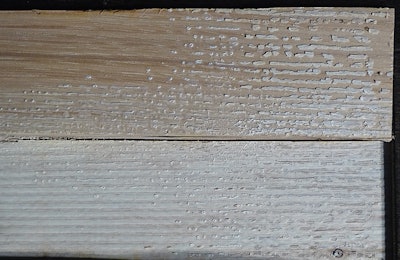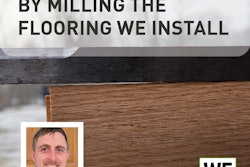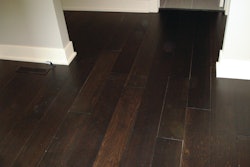
 Pulling up some boards revealed the wrong trowel had been used, with not enough adhesive transfer.
Pulling up some boards revealed the wrong trowel had been used, with not enough adhesive transfer.
The Problem
I received a call from a retailer expressing a concern about several loose spots on an installation.
What Happened
This job was engineered 3/8-by-3-inch wood flooring and had been installed using a urethane adhesive over a concrete slab on the ground floor of single-family home.
The Inspection
Upon arrival we saw many locations marked by blue tape throughout the floor. My first thought was "hollow spots." As I tapped the various areas with my fingertips, it was apparent the flooring had released from the adhesive. We discovered that the spots were much larger than a "normal" hollow spot (if there is such a thing), and we decided to open the floor up to see what might be the issue.
The floor was extremely easy to pry off the subfloor, which is highly unusual when using urethane adhesives. The trowel notches were the size of a trowel that would be used for a vinyl floor—not even close to being correct. There were also bare spots on the back of the flooring where the flooring had bridged over the adhesive, making a hollow spot.
How to Fix the Floor
When hollow spots are small, then the injection method of repair may be used, but not on this floor. In this case the entire floor needed to be removed and replaced using the correct trowel notch (with the subfloor flattened to within specs).
In the Future
Trowels are probably the most important tool when installing a glue-down floor, because they measure the amount of adhesive required for the flooring being installed—the size notches required are different based on the flooring used. I am always asked how long a trowel will last, but this is difficult to answer because it depends on how rough the substrate is. A trowel will retain its correct-size notches on plywood much longer than on concrete. I recommend having two trowels or more for each installation, and comparing the trowel you're using with a new one. If there is the slightest indication of wear, use a new one—the cost is insignificant compared to the cost of your job.
Manufacturers go to great lengths to recommend the correct trowel for all flooring applications; there are diagrammed measurements and pictures on all buckets, flooring instruction that come in flooring boxes, and on all product websites.
I receive calls for just about anything an installer or retailer may have a question about. Answering their questions is what manufacturers' employees like me are for. The last thing we want to get is a claim call, so please call us with any question or issue before problems happen.
RELATED: Sticky Questions: Q&As on Essential Adhesive Know-How

































